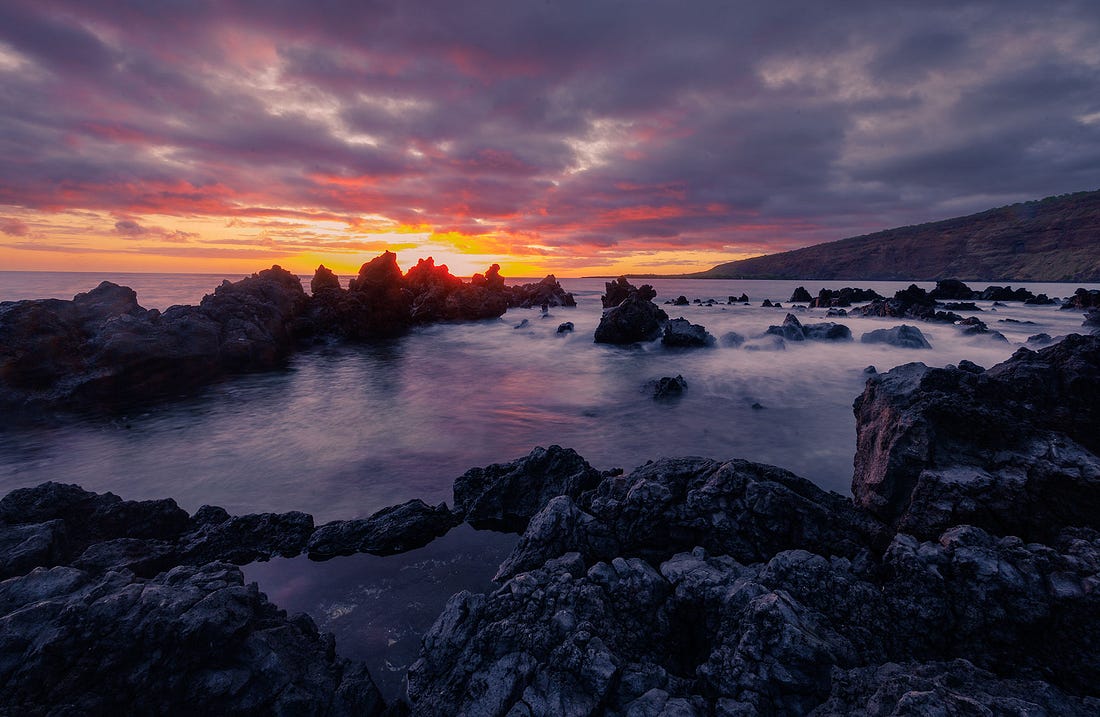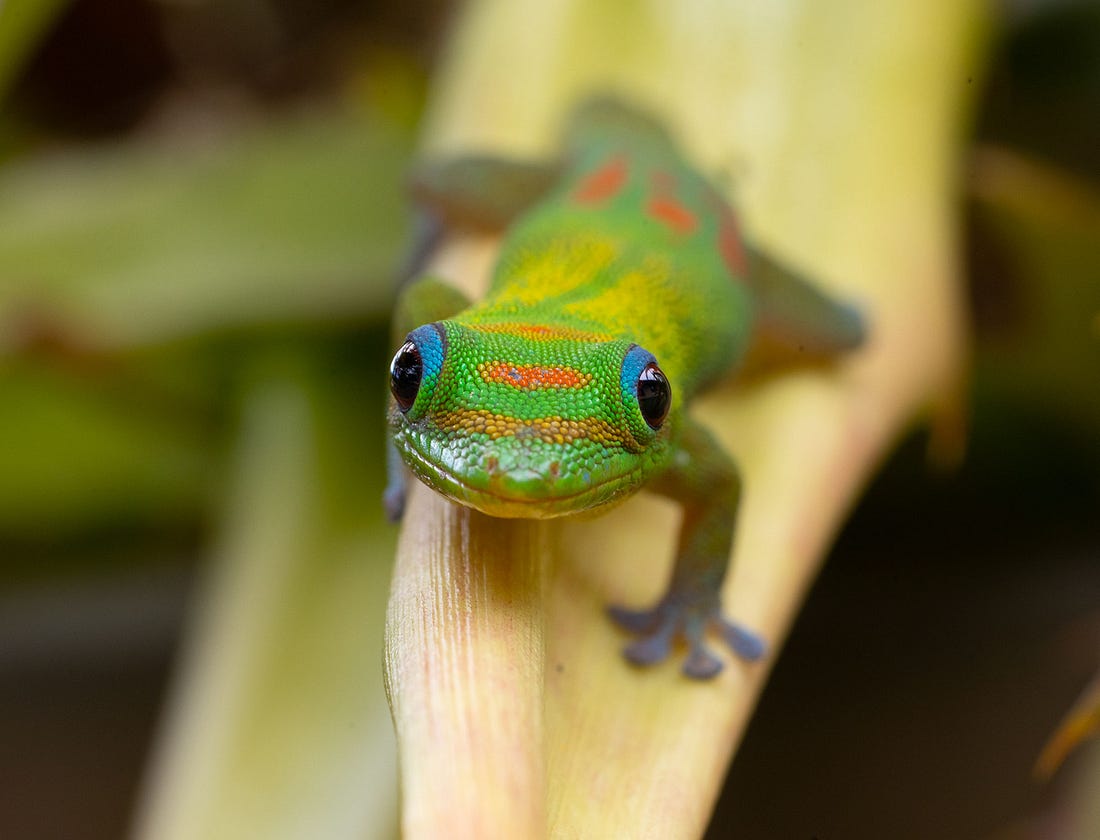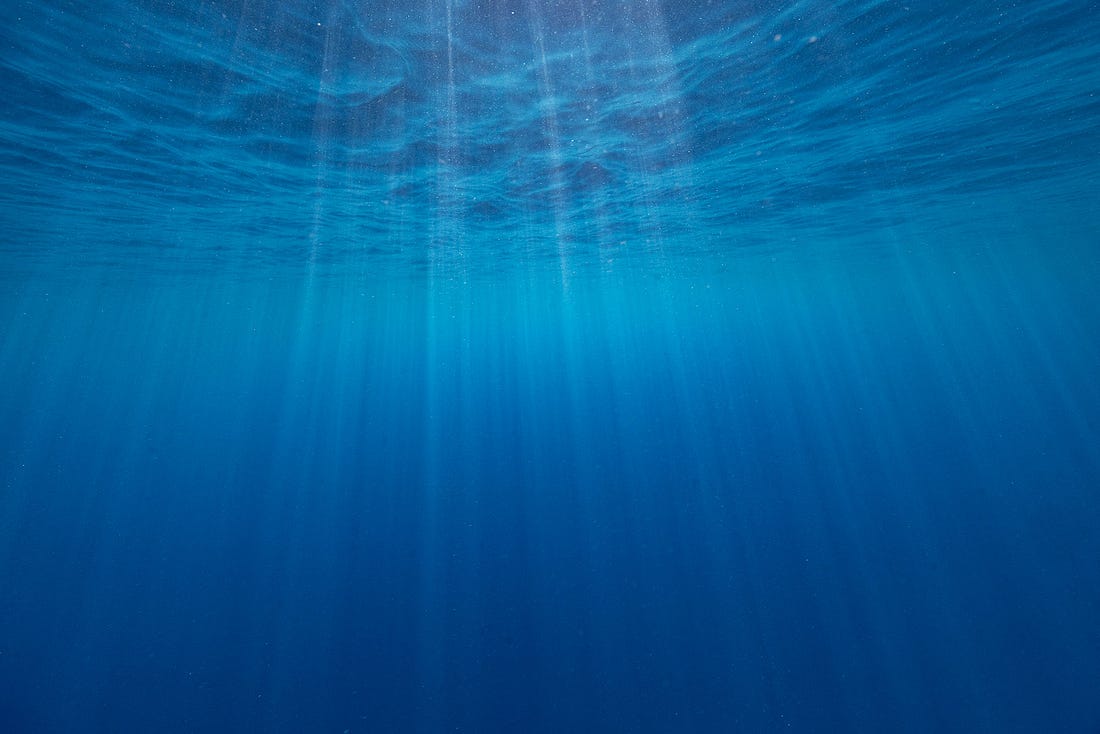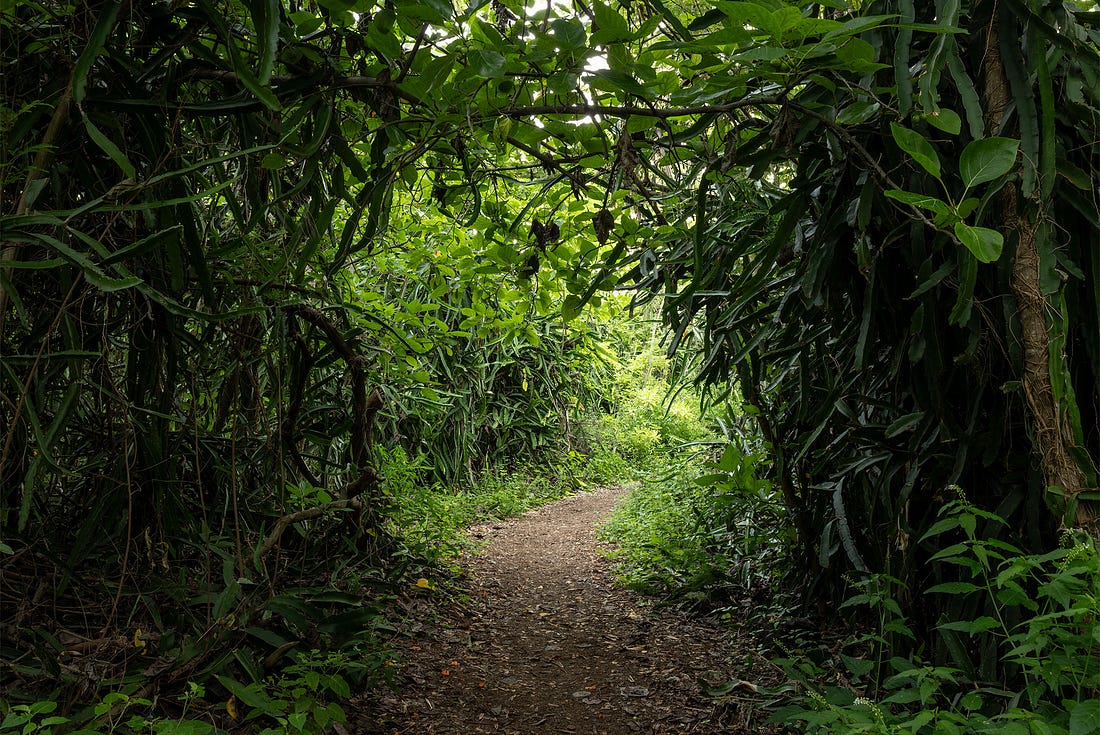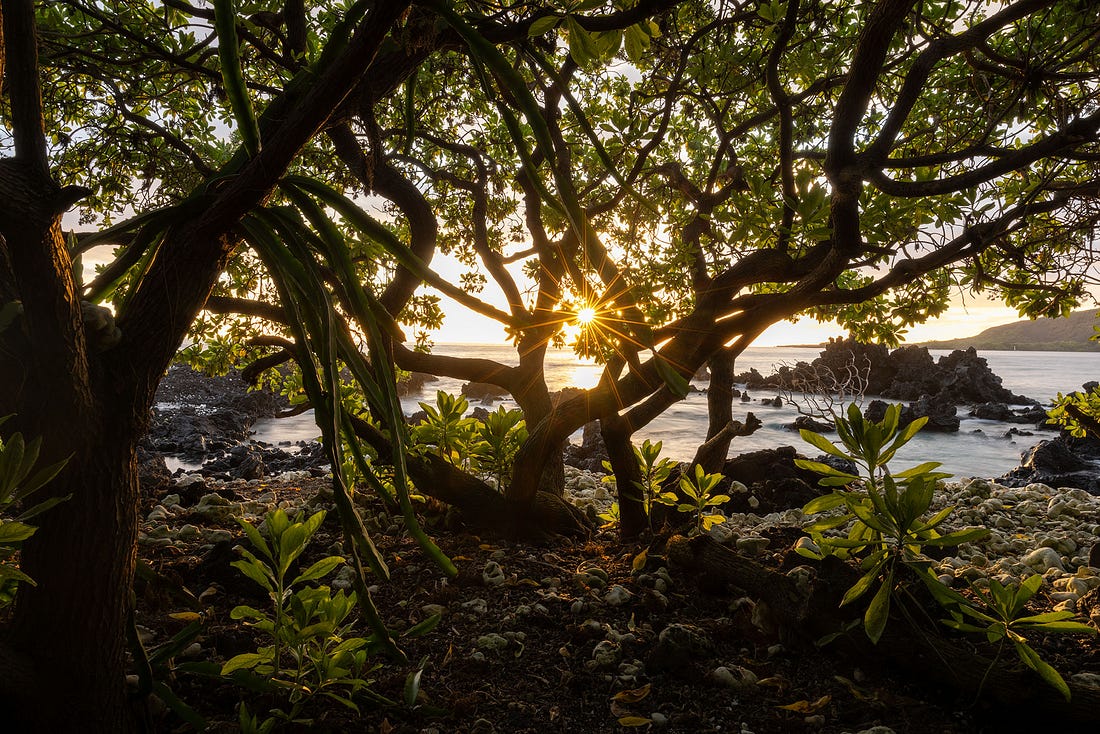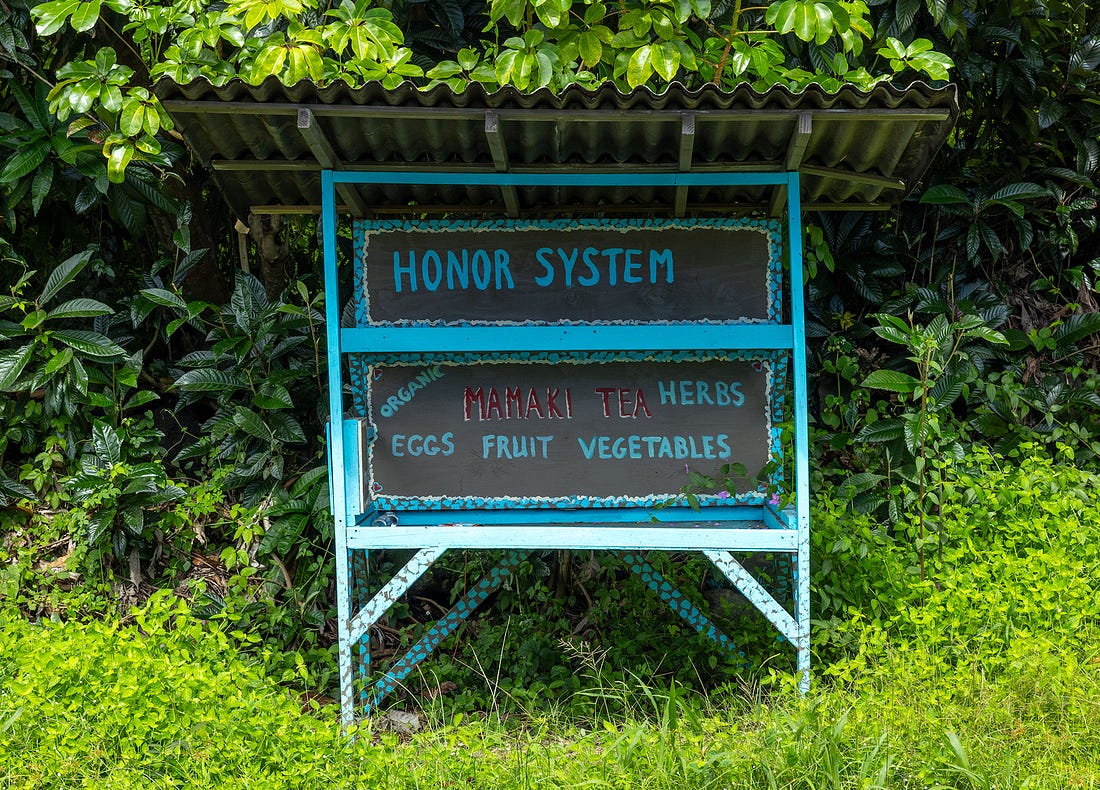Paddling Kealakekua BayIn Hawai'i's legendary bluewater bay, I envision how an ancient Hawaiian battle unfolded, imagine native reforestation, and paddle to the island's most vibrant reef.I originally published this story in fall 2024 on Notes from the Road. Like most shorelines on the island of Hawaii, the rocky Manini Beach is not really a beach, but just a rare flat grassy space with a tiny spot where it’s safe to swim at low tide. But Manini Beach is magnificent, and it looks out over Kealakekua Bay, one of the most pristine coral reef and crystal-clear blue water bays in all of Hawaii, and the site of perhaps Hawaii’s most pivotal historical moment—the killing of English explorer James Cook. Somehow, I didn’t make the connection that I happened to be reading the last thrilling pages of Hampton Sides’ The Wide Wide Sea, about Captain Cook’s third and final voyage, while staying here in the city of Captain Cook, until this very moment. Perhaps the sign of a good history book, The Wide Wide Sea made me want to know about the things that were beyond the scope of the book; beyond the scope of the long and daring voyage that ended with Captain Cook taking Kalaniʻōpuʻu, the Supreme Chief of Hawai‘i Island hostage, resulting in an uprising that led to Cook’s brutal, and unfortunately, justified death. Reconstructing Kalaniʻōpuʻu’s Sea BattleAt the time of Cook’s arrival in the Hawaiian Islands, the islands’ chiefs were jockeying for power, and engaging in regular inter-island battles, many of which played out at sea and on the beaches of Maui, Lānaʻi, and Molokaʻi. Kalaniʻōpuʻu, had been away, at war with Maui, when Captain Cook was enjoying being celebrated as the embodiment of the God Lono while moored in Kealakekua Bay. Looking out at the ocean, I am trying to imagine what Kalaniʻōpuʻu’s returning fleet actually might have looked like when it arrived in this bay to find two British vessels harbored there. His fleet might have consisted of up to as many as 12,000 men, in a fleet of hundreds of vessels. Most of these would have been Hawaiian double-hulled canoes, known as wa‘a kaulua, which were highly versatile and durable - this was the boat style that Moana sailed in the Disney cartoon. These double-hulled canoes were designed for stability on big open ocean water, even when filled with dozens of warriors. Built with Hawaiian koa wood, these hulls were roped together with coconut fiber. This gave them a less than rigid structure; the hulls could flex in rough seas. Scattered among the wa'a kaulua canoes would have been wa'a kaukahi canoes – single-hulled and helmed by single paddlers. These canoes were light, easy to maneuver and designed to scout ahead of the fleet, or to open surprise attacks. Canoes with larger decks, the pahi, were much larger and had wider platforms between the hulls. This allowed them to be used to hauls the heavy gear: food, weapons, and everything needed to support protracted land invasions.
When Supreme Chief Kalaniʻōpuʻu returned to Hawai‘i Island from his battle with Maui, his warriors would have carried an assortment of weapons, all crafted from material wood, stone, and shark teeth. One of the most commonly used weapons was the leiomano, a shark-toothed club and dagger. The teeth were lashed to the edges of the wooden club, creating nasty a serrated weapon that could inflict deep cuts and tear flesh in battle. Another essential weapon for the returning fleet would have been the pahoa, a wooden dagger used in hand-to-hand combat. Its pointed end was sharpened to cut through flesh. The invading warriors would have been trained to strike The ihe, a long wooden spear, was used in both ranged and close combat. Warriors would thrust or throw the six to eight foot long spear whose sharpened point was hardened by fire. The la‘au palau, a long wooden club or staff would have also been aboard the returning ships. These clubs could be as long as six feet and were used to strike opponents with heavy, crushing blows. Some clubs were designed with rounded or spiked ends. Warriors also used the newa, a short, heavy club made from dense wood or stone designed for close-quarters combat and often used as a secondary weapon. Warriors would use this powerful weapon to shatter bones and knock opponents unconscious. The ka‘ane, a strangling cord, was used to incapacitate enemies in hand-to-hand combat. Made from braided plant fibers, this weapon could be quickly wrapped around an opponent's neck. Hawaiian warriors also protected themselves with pahoa koa, large wooden shields. Such shields may have been used aboard the canoes in battle. We know a little now about the weapons that Kalaniʻōpuʻu brought to battle, but what about an actual battle? How might one have actually played out? Kalaniʻōpuʻu’s fleet would have set sail from this Kona-side coast of Hawaiʻi, crossing the treacherous ʻAlenuihāhā Channel, which separates Hawaiʻi Island from Maui. Predicting weather, waves and tides would be a key component of the crossing and warfare itself. Unlike warfare in other parts of the world, this Polynesian style of warfare would have evolved from a thousand years of a sea-based and seafaring lifestyle. Kalaniʻōpuʻu’s advisors would likely take advantage of calm seas and favorable winds, and perhaps surprise Maui’s shores in a dawn attack. As they neared the shores of Maui, their scouts might have noticed sentries on land. Drums might have been beaten from the cliffs above Lahaina, signaling the arrival of the Hawaiʻi fleet - a signal to Maui’s defending fleet and land-based troops. Too late for a clean landing, a Maui fleet would have met the attackers. Perhaps several advisors, like modern day commanders and generals, made real-time battle decisions from the rear on a number of giant pahu ships, using conch shells and drums as a form of battle cry communication to the front. Dozens or hundreds of double-hulled wa‘a kaulua formed crescent-shaped attack formations heading for the Maui coast. The goal of these crescents would be to encircle and separate the defending fleet. The Hawaiʻi fleet would likely be stronger and more skilled at sea. They would likely aim to force their way through to Maui’s shores to engage in a land battle. Maui’s fleet, commanded by Maui’s Supreme Chief Kāhekili’s naval captains, would attempt to stop the invasion in the channel, using their keen understanding of their own coastline. In the open ocean, the battle would have been about tactical maneuvers. The two fleets would try to position themselves to exploit the favor of the winds and swells, trying to gain advantage in both speed and positioning, almost like a game of chess. This maneuvering was critical to the sea battle: It would determine which side would have the advantage in the first strike. This battle begins with long-range attacks using projectiles before the canoes closed in for direct engagement. First in use would be the long-range ma’a slingstones, which would act equivalent to longbows in European feudal battles. The maʻa slings would launch smooth stones with great force and accuracy at enemy canoes, with the goal of knocking out or killing the enemy long before direct engagement. As the forces closed in, ihe spears would be thrown from one canoe to another at a closer range. Warriors on both sides would have been training their whole life to deflect or even catch incoming spears, but a well-placed throw could take out key members of the opposing crew. A direct blow to a captain would create chaos on an enemy craft.
As the navies approached each other, Kalaniʻōpuʻu would likely be ready to employ one of the most aggressive naval tactics—ramming. His frontal Waʻa kaulua would have been sturdy enough to withstand collisions, and commanders could order their rowers to gain speed and angle the canoe to strike a vulnerable section of the enemy canoe—often the side, where it would be most unstable. Such a blow could damage or even capsize the targeted canoe, throwing its warriors into the water, where they would be vulnerable to further attacks. On a larger level, a series of these sudden and fast ramming strikes could break up the opposing fleet's formation, forcing enemy canoes to scatter. This tactic was risky, especially since Maui would have another strategy—a strategy that may change the course of the naval battle. Once in close range, the battle would involve a series of skirmishes between groups of canoes. Warriors would begin to hurl stones, ihe spears, and ma’a projectiles would be flying across bows. As canoes were hit, warriors would leap from one boat to another, and hand-to-hand combat would ensue. Once the canoes were in close proximity, boarding skills became critical. Now, the Pāhoa dagger, the shark-toothed leiomano clubs and the Lā‘au palau spears would be employed. Hawaiian naval warriors were trained for close combat on unstable platforms, they had practiced these balancing acts their entire lives. Boarding maneuvers would have been incredibly dangerous, as warriors would have to maintain their balance on the rocking, fast-moving canoes while shark-toothed clubs would be swinging at them. In this phase, warriors from one canoe would leap onto the opposing vessel, engaging in fierce combat to take control of it. Canoes were vulnerable once boarded because they could be capsized or the crew overwhelmed. What is most important for the battle is not what happens between any one engagement, but the bigger picture. Commanders would have understood the value of outflanking and surrounding enemy canoes. One possible strategy would be to engage in a coordinated flanking attack - remember that craving formation - designed to encircle and cut off a segment of the defending fleet. From here, it becomes easier to outnumber and take down individual canoes, one at a time. Maui’s fleet likely consisted of more of the smaller single-hulled wa‘a kaulua canoes, which were ideal as coastal defenders. These agile craft could dart in and out of the main battle, striking with mo’a projectiles and retreating like oceanic guerillas. But if Hawaiʻi was hoping to outflank Maui with their larger, more aggressive craft, Maui had been planning to lure the Hawaiʻi fleet into the reefs. This surprise tactic might have done the Hawaiʻi fleet in, for dozens of wa‘a kaulua canoes would get reefed. Once reefed, Maui could finish these attackers off with a surprise force, hiding in the coves and ready to safely hurl ihe and mo’a stones on the reefed attackers. This setback for Kalaniʻōpuʻu would mean a land invasion would be impossible. Perhaps the objective now would be to finish off as many Maui canoes, rescue the reefed warriors, and retreat. The actual outcomes of these Hawaii-Maui battles is not actually known. All we know is that when Kalaniʻōpuʻu returned to Hawaiʻi, there had been no decisive victory or defeat. Perhaps it was this meeting with Captain Cook, and the understanding of the superiority of European guns and cannons, that would be Kalaniʻōpuʻu’s protege, Kamehamaha’s secret advantage over Maui. Maui was defeated 11 years later as Kamehamaha came armed with European guns and cannons. The complete unification of Hawaii would come shortly after, as Kamehameha continued his campaigns across the islands.
Mongooses, Mosquitos and the Puʻu ʻŌʻō TrailWhile most of Hawaiʻi’s southwestern Kona coast is dry, almost rain-free, Kealakekua Bay and nearby Captain Cook are lush. The terrain is steep. Rain, mist and clouds come rolling down the volcanic slopes, producing a dense, jungly atmosphere. We are sitting under the awning of a small poke restaurant, looking out at the rain, the wall of trees, ferns and vines towering on the other side of the road. African tulip trees, mango trees from South Asia, plumeria from Central America, Royal Poinciana from Madagascar, Norfolk Island Pine from the South Pacific, Pineapple from South America and banyan trees from India. Everywhere you look, the jungly terrain is made up entirely of the rest of the world. Jacaranda from South America, Eucalyptus from Australia, ficus from Southeast Asia, bougainvillea from South America, Hibiscus from Asia, Papaya from Central America, Kiawe from South America, Monkeypod trees from the Americas and Plumbago from South Africa. Among this botanical wonderland, I cannot place a single native Hawaiian plant - but then, suddenly, a hawk strikes at something midstory. I run across the road to look at it—it’s a Hawaiian Hawk, endemic to, and known only from the Big Island. Everything native to Hawaii came from and evolved out of organisms that came from somewhere else; and this is why islands like the Hawaiian Archipelago have huge gaps in their evolutionary development. There is only a single native mammal species, a bat. There are no native land reptiles, amphibians, or snakes, no deciduous trees or cacti or native grasslands. Despite these gaps, Hawaii’s native biology is robust. Of the 1400 native plant species, ninety percent are endemic. Of 10,000 native insect species, 87% are endemic. Of the 680 fish species, 25% are endemic. And of the 140 native bird species, 70 are endemic. But why then am I not seeing those native plants, and why is this Hawaiian Hawk the only endemic bird I’ve seen? As we order our poke, I notice something flash in the distance. It’s a small lizard, and even though many lizards are green, this brilliant lime green is unusual even among reptiles. As I look closer, I see that this is a Gold-dust Day Gecko—it’s from Madagascar, and like all lizards on the island, it exists because last century, many people kept, and released their captive pets. I have always wanted to see a Gold-dust Day Gecko, they are one of our most beautiful animals on Earth. But seeing it here in the wild is bittersweet. Because it is not native, I feel like I am looking at an animal in a zoo. I cannot see it as being real. The Big Island is crawling with non-native lizards, but much more noticeable are the mongooses—slender and devious looking carnivorous mammals that were released in the Hawaiian Islands to predate rats. Since rats are active at night, the mongooses failed at their job and instead began to eat up native bird eggs, sea turtle hatchlings and young Nēnē geese.
Lessons about the Bay from the Puʻu ʻŌʻō TrailI wake my family early in the morning. We’re headed to the Puʻu ʻŌʻō Trail, a high elevation path on the slope of Mauna Kea that traverses through several kīpuka, old-growth forests that have survived repeated lava flows. The Puʻu ʻŌʻō Trail is not particularly popular, but it does attract botanists and birders interested in the island’s native life. There is only one other car at the trailhead. We head out on the path between bare black lava rock, and almost instantly, Jane and Kellan eclipse me. I will not see them for the next two hours. But what a mistake they are making, mindlessly moving! Missing everything I would otherwise show them! I run into a pair of birders. One of them, Jeff, is a retired USGS ecologist who spent part of his career studying declines among the native birds of Hawai‘i Island. He helps me identify the greenish-yellow honeycreeper, a Hawai‘i Amakihi, flitting about in a trailside tree. Everybody knows that the native birds of the Hawaiian Islands, including those endemic to Hawai‘i Island, are in serious decline, and tend to live in isolated pockets such as these high elevation kīpuka forests that weave between the lifeless black lava flows. I ask him, “there is so much great habitat in places like Captain Cook, so much jungle! Why don’t I see the native birds there?” “It’s important to understand that all the native birds used to live everywhere,” Jeff explains. “At every elevation, all the way down to the ocean. In the middle elevations, their habitat was lost to agriculture. But at the lower elevations, of all different non-native threats, it’s avian malaria that is the culprit. The mosquitos are not native, but it’s the malaria they carry, also not native, that kills the native birds. Those mosquitoes thrive in the humid lower elevations. That’s why the birds only live at the high elevations, it’s the only place where the mosquitos can’t live.” He explains that there are two strategies to save the native birds, and bring them back to all elevations. “You can release modified male mosquitoes that don’t produce offspring,” he says. When they mate with female mosquitoes, it can help reduce the overall mosquito population.” “But,” he explains, “You can also release genetically modified mosquitoes that are resistant to avian malaria. These mosquitoes wouldn’t carry and spread the disease.” “Unfortunately, such a program would cost ten million, and there’s no budget for that.” I am incredulous at how small the cost is. “Ten million, that’s nothing!” Jeff agrees, “you would think some millionaires could band together and get something like that paid for.” After parting ways with the birding duo, I begin to wonder why there seems to be a general lackadaisical attitude on Hawaiʻi Island to non-native threats in general. You can feel the passion for protecting sea turtles and marine mammals, like native dolphins and Hawaiian Monk Seals, but that doesn’t seem to translate to the land itself. Supposedly, Hawaiʻi Island has the best mongoose population control of all the islands, but if that were really the case, how is it possible that those cheeky long sneaks scurry about in the back alleys of Kona, in the bushes by every beach and alongside every road. I’ve always seen Hawai‘i as the state most dedicated and determined to preserve its culture. But why, then, is there not the same deliberate, sustained passion on Hawai‘i Island to restore the native forests, wetlands, streams, and wildlife? Reducing mosquito populations is one thing, but why not think big? Why not reforest Hawaiʻi Island’s middle and high elevations? Reintroducing trees like koa, ‘ōhi‘a, and other native plants would recreate the natural forest structure that native birds need to thrive. Sure, there will always be future lava flows, but a sustained effort to bring back native forests could account for the fact that some will be lost. Recreating native wild habitats isn’t just about government money. Some of the most effective efforts to restore lost wild habitats around the world happen because of the community’s passion for it. A committed community means local buy-in, volunteer labor, local fundraising and sustained education. The mongooses wouldn’t stand a chance.
Ka'awaloa Flats and my Pivot to the PacificI try waking Kellan up, but he won’t budge. I had rented us a pair of kayaks to cross Kealakekua Bay and snorkel at the famously clear water coral reef, replicating the same trip we made a few days ago. I finally give up, and jet out myself. On my way down the slopes, I can see the other side of the bay. The ocean is glass, and there are hardly any dive boats. My kayak is waiting at a small cove. The two young operators recognize me, and say, “It’s looking good out there, brah!” I ask them why there are so few boats out there. “Some time it just happens. Empty out there!” I can’t wait to get out there. The best days of my childhood were long snorkeling days, and the best days of my fourteen years in Los Angeles were long days solo paddling in the Pacific. But I’ve mostly ignored my dual life passions as an adult, and I saw this visit to Hawaiʻi Island as a chance to course correct. Like Obama’s “Pivot to Asia,” I used to call this my “Pivot to the Pacific.” As I paddle across the bay, I see something I’ve never seen before—the shafts of sun rays that people often see underwater, I see from above water, and they are forming shapes akin to ethereal, moving mandalas. It is a reminder of why this bay is renowned for its underwater clarity—without nearby runoff, or beaches, and a quick descent to the depths, the narrow coral band is often among the clearest waters in the islands. You can see the white obelisk from anywhere in the bay. This obelisk, erected in 1874 by the British Royal Navy to commemorate the life of Captain Cook at the place of his death, is also a great beacon for locating the reef. As soon as I reach it, I jump in, letting the kayak float tethered behind me. One experience I’ve always had snorkeling with others is that there is often this sense that the snorkeling is something to finish, and be done with. Almost without fail, my fellow snorkelers will say something like, “there aren’t that many fish!” or “it was much better in Cozumel” or, “I’ve seen everything I need to see” or, “the water’s not very clear.” No—I want to be in the water all day. As long as the water is warm, that is where I want to be. I don’t need the best visibility, or the most fish. I have spent 8 hour days snorkeling in turtle grass flats, where sealife is less abundant. There is always something new to learn, something surprising to see, wherever you are. That’s when I see the slender animal, a sinuous ribbon of white and black spots, flowing through the shallow reef. At first, all the alarms go off, even though, deep down, I know that sea snakes are rarely dangerous to humans. But on the other hand, I am in a small enclosed space with this creature; a shallow sandy area nearly entirely closed by coral structures. Could he strike me in a panic? But then I calm my nerves and reconsider what this animal might be. Is this really a snake? I decide to float there above it, watching it until I can figure out what it is. I stay with it for nearly fifteen minutes, while, like liquid metal, it weaves through the tiniest holes and crevices of the coral walls around us. Finally, I see its face closely. While everything about this animal makes it look like a snake—its pointed head, its round, tube-shaped body and its unusual free-swimming movement—a close-up view of the face is a dead giveaway. My murky internal catalog of Hawaiian fish species finally registers. This little beauty is a snake eel. Species: Magnificent Snake Eel—a moray that look like a snake. Problem solved. While I was involved in a moray eel attack as a child, I have no fear of this 18-inch phantom. Pivot to the Pacific achieved. Notes from the Road is free today. But if you enjoyed this post, you can tell Notes from the Road that their writing is valuable by pledging a future subscription. You won't be charged unless they enable payments. |

